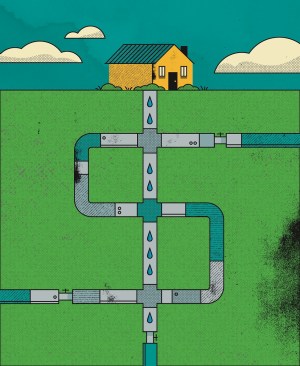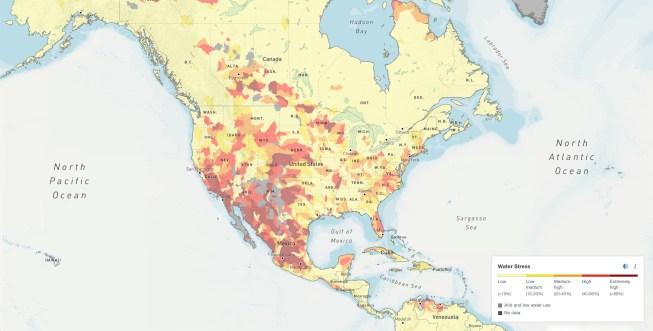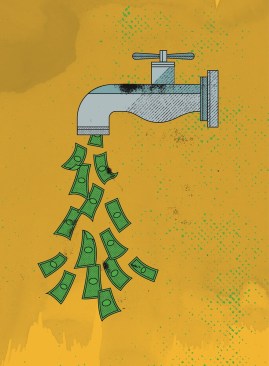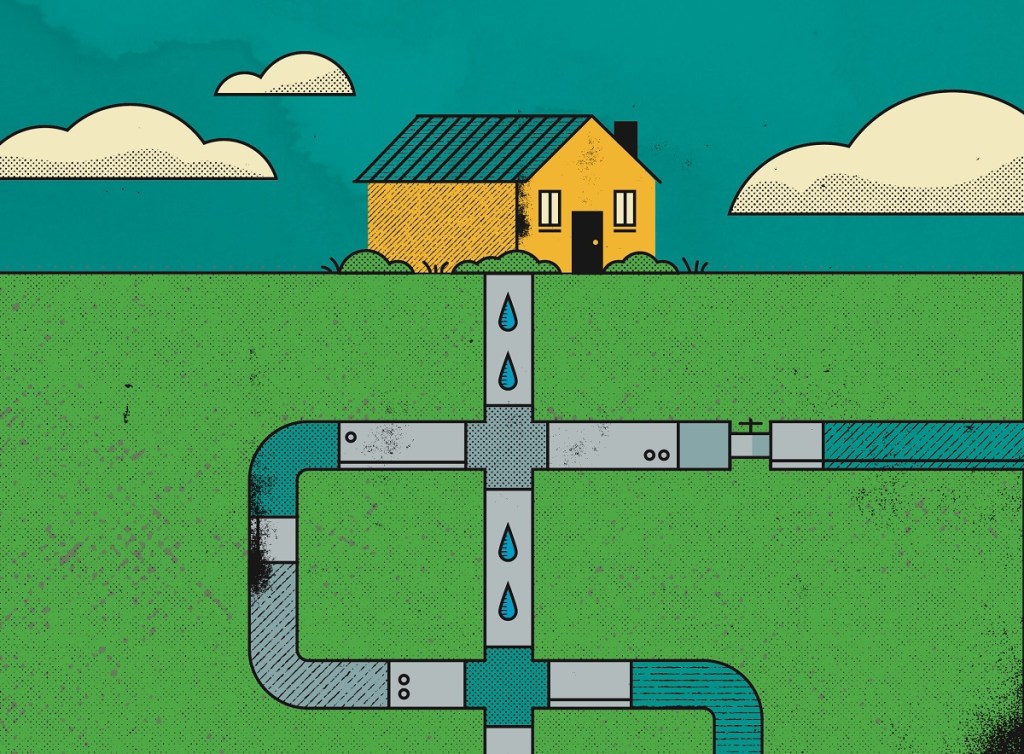
Woody Harrington
Craig Karn has seen the future of access to water for home building, and it looks expensive.
A landscape architect and land planner in Colorado who grapples with the state’s myriad water restrictions and advocates for “total hydrology management” with his home builder clients, Karn has watched tap fees in the region skyrocket.
“Water is becoming economically unavailable,” says Karn, a longtime member of the NAHB’s Environmental Issues Committee who currently chairs its Water Issues Task Group and is founder of Denver-based consultancy Consilium Design. “What we’re seeing across the West are increasing costs and, in some cases, just lack of availability of water. Tap fees are going through the roof.”
He points to the city of Thornton, Colorado, which recently proposed to increase tap fees by 62%.
“That’s $40,000 a door just to have the right to have water,” Karn says, noting other examples in the region that are making development increasingly expensive. “Most jurisdictions here, you can’t annex your property if you’re not bringing the water with you.”
A client attempting to develop townhomes in Parker, Colorado, was targeting prices in the $400,000 range. But when they penciled in the $41,000 tap fees in that municipality, they realized prices would need to be $500,000 or more.
“We just place so much of the burden for water infrastructure and expansion on new construction,” Karn says. “Water has gotten so expensive, it is stopping annexation and development in a lot of jurisdictions here.”
Water Worries
Karn isn’t alone in sounding the alarm about higher water fees, or the potential for the availability of water to constrain growth in the years ahead. While increased energy efficiency of new homes has been top of mind for home builders for nearly two decades, water use hasn’t garnered as much attention, even amid water efficiency gains for new homes built today. Despite that progress, builders on the leading edge of conserving the enabler of life on our planet say we have fallen woefully behind with a comparable focus on water, as well as the behavioral changes that come with it, and that a reckoning is surely coming.
“Water’s just an afterthought,” says Darrel McMaster, owner of Boerne, Texas–based Sustainable Homes outside San Antonio, whose Point Source Homes leverage rainwater harvesting to meet domestic water needs. “Half the free world is moving to Texas right now, and there are only so many straws you can put in the drink.”
Drew Smith, chief operating officer at Parrish, Florida–based green building certification firm Two Trails, says energy and water don’t have to be an either-or choice for home builders. “Everyone has been focused on energy, so they’ve kind of forgotten about water,” Smith says. “But it’s a natural resource, and there’s only so much of it.”
A Sustainability Failure Point
For Kim Shanahan, a home builder in Santa Fe, New Mexico, which gets an average of 14 inches of annual rainfall, the issue hits particularly close to home.
“There’s a sustainability failure point where growth, which is going up, intersects with water supply, which is going down, and you’ve suddenly got no new development,” says Shanahan, who refers to himself as the canary in the coal mine when it comes to home building and water. “Water is the only thing that has ever been imagined that can actually stop growth.”
The issue has become even more urgent in 2021, as some of the fastest growing new-home markets in the country are also in areas with extremely stressed water resources.
“There’s been a huge population shift from the North to the South, and into arid regions in the Sun Belt where there isn’t significant recharge for groundwater,” says CR Herro, vice president of innovation at Scottsdale, Arizona–based Meritage Homes, the sixth largest home builder in the country. “Higher population, coupled with unmanaged water consumption at the residential and commercial level, are really a disaster in the making.”
High Water Stress in Fast-Growing Markets
According to the World Resources Institute, a Washington, D.C.–based global research and conservation group, domestic water consumption has increased 600% worldwide in the past 50 years, far outpacing industrial and agricultural use, with the United States consuming the most water, per capita, among 30 developed and emerging economies.
While those data telegraph the growing urgency of the issue globally, WRI’s Aqueduct Water Risk Atlas of regions facing high or extremely high water stress in the U.S. provides a form-fitting overlay to some of the fastest growing new-home markets on our latest Local Leaders list, including Dallas-Fort Worth (No. 1), Phoenix (No. 4), Denver (No. 13), Las Vegas (No. 15), Riverside (No. 14), and Sacramento (No. 27).

This interactive map from the World Resources Institute allows users to analyze current and future water risks across locations. It's accessible at wri.org/aqueduct.
“Water stress is a measurement that compares total water withdrawals to the available renewable surface and groundwater supply in a given area,” says Leah Schleifer, a research and engagement associate for WRI’s Water Program. “It’s supply versus demand for water. But if you want to get even more basic, you can just call it competition.”
In those areas facing extremely high water stress, that means 80% or more of the region’s available water is being withdrawn from the underlying aquifers or surface supplies.
“If you’re walking that thin line already, that gets pretty problematic in years where you have an anomaly event like a drought,” Schleifer says. “It could take you over the edge where there’s simply no water left.”
No Water, No Permit
For industry professionals in the West, that situation is already upon them. Take Perry Brätt, founder of Stratton & Brätt Landscaping in Utah, whose very business relies on access to water.
“Depending on which reports you read, Utah is a leader for housing demand,” says Brätt. (Provo-Orem ranks No. 30 on the latest Local Leaders list; Salt Lake City is No. 35.) “Water is going to drive whether we can meet it.”
A New Benchmark for Water Efficiency
While efforts of smaller home builders to deliver highly water-efficient homes offer promise, the real question is whether the concept can scale to a production level.
“I don’t think anything’s impossible,” says Dan Bridleman, senior vice president of sustainability, technology, and strategic sourcing at Los Angeles–based KB Home, the seventh biggest home builder in the country. “One of my favorite movies is the one where Matt Damon has to figure out how to grow potatoes on Mars. And he uses science to do it.”
KB Home is a production builder that has been on the leading edge of water conservation for decades. In 2005, it built the first house to qualify for the Southern Nevada Water Authority’s “Water Smart Home” designation to save up to 75,000 gallons of water per year. In 2006, it began installing fixtures designated under the U.S. Environmental Protection Agency’s WaterSense program, and in 2011, it unveiled the program’s first WaterSense labeled homes, of which it has since built 16,000.
Last year, KB Home built the first home labeled under the EPA’s WaterSense Version 2.0 program, which incorporates the new Residential Energy Services Network (RESNET) HERSH20 whole-house water efficiency rating system, during a pilot in Henderson, Nevada.
“This isn’t just a flavor of the month for us,” Bridleman says. “This is important from a natural resources point of view. We’ve saved over 1.5 billion gallons of water annually for all these homes that we’ve built.”
RESNET’s new program, similar to its existing HERS energy score, benchmarks a home against one built to code in 2006, with a lower score designating a more efficient home.
To achieve WaterSense 2.0, KB had to hit a 70 rating. Its pilot home earned a score of 57, meaning it is roughly 43% more water efficient than a similar home built in 2006.
Akin to the blower door tests used to give energy ratings for homes, RESNET inspectors note the efficiency of installed dishwashers and washing machines, and use flow and pressure loss tests to measure the water efficiency of a new home.
“It really builds off the HERS Index,” says Ryan Meres, program director at RESNET. “It’s the same type of index, basically from 0 to 100, where a lower number means a more water-efficient home.”
The rating has been in development for about five years and was officially rolled out during the pilot in Henderson, with participation from 10 builders, including KB. While older WaterSense ratings were prescriptive, the new program is performance-based, to bring it in line with energy ratings. Meres says the program came about due to the pressing needs builders and municipalities are facing across the country for water.
“There’s a real possibility that in some of these jurisdictions that are growing so fast and who have limited water resources that they’re going to get to a point where they have to put a moratorium on building, or require that homes meet a very stringent water efficiency standard,” Meres says. “That’s one of the places where we see HERSH2O could be a good fit, because it’s performance based. They could set a target to say, 'If you want to build here, you have to hit a HERSH2O score of 50 or less.’”
He points to one project in his area where a local developer wanted to expand his project by 29 lots. But the city wouldn’t approve the permit unless the developer agreed to install a new water tank to serve not only those additional houses, but other development throughout the region, an increasingly common request. The developer balked and is now trying to partner with other developers to share the cost.
“There are different situations across different markets in Utah, but I don’t know of any area where it is safe to say there isn’t a problem with water,” Brätt says.
For others, a simple mantra has become commonplace for figuring the likelihood of municipal approvals: “No water, no permit.”
That’s how Ted Clifton, president of Coupeville, Washington–based Zero-Energy Home Plans and former chair of NAHB’s Water Issues Task Group, sums up the inevitable outcome of a finite resource meeting ever-growing demand.
“If there is no water left to allocate to the next single-family home, that home doesn’t get a building permit, period,” Clifton says. “That’s true pretty much everywhere.”
Growing Attention to the Issue
While the home building industry as a whole hasn’t promoted water efficiency to the same degree as energy in recent decades, that is beginning to change. Running out of enough available water to build homes was a concern reflected in a resolution on water conservation adopted at the NAHB’s Winter 2021 Leadership Meeting.
“Federal action, to date, generally has been limited to setting water use standards for plumbing fixtures and appliances,” the resolution read, “yet extended regional droughts and inadequate water supplies have pushed state and local agencies to undertake historic water conservation measures, including placing regulatory restrictions on the housing industry.”
The resolution went on to encourage more conservation measures, as well as calling for action to retrofit existing homes—which account for the lion’s share of consumption—to help ensure that there are enough water resources in stressed areas to serve all needs for existing and new homes.
Credit Where Credit is Due
One thing is certain: New-home builders have made gains on the water efficiency front.
In terms of average consumption, a new three-bedroom, single-family home with four occupants in California today uses 31% less water than an equivalent home built in 1992, according to the California Building Industry Association, and 50% less than a home built in 1980. That represents a savings of 47,000 gallons of water per home, per year. The inclusion of 1.28 gallon toilets by code in the Golden State since 2016 has made a big difference, since toilets account for the single greatest share of water use inside the home, according to NAHB.
WRI data show total water withdrawals in the U.S. decreased from 2005 to 2015, including water used in households, even as population and GDP grew. In fact, the organization points to the U.S. as an exemplary model for other growing countries to follow. Schleifer calls out the increased use of high-efficiency appliances in new homes as a likely contributor.
Room for Growth
At the same time, given the increasing demand for water in growing new-home markets, there is still more that needs to be done.
For example, in its 2020 Green Homes SmartMarket Brief, Dodge Data & Analytics found that while 67% of builders focus on water efficiency in some homes, only 36% do so on most of their projects. (By comparison, a full 91% emphasized energy efficiency in at least some homes, while 69% did so on most builds.)
And even though data from the CBIA suggest new homes, in California at least, are more water efficient than those built in the 1980s and 1990s, they also tend to have more taps and appliances out of the gate.
A 2017 NAHB study found that homes built before 1960 tend to use less water than newer ones, possibly because they are also less likely to have swimming pools. But the same study found that after that date, average water use varies only slightly among single-family homes of different vintages.
One reason why may have been the home building industry’s earlier attempts at water efficiency in the 1990s that resulted in low-flow fixtures and toilets that weren’t quite up to snuff when introduced.
“As you may recall, when we first started to do that, it was very frustrating to the homeowner and to the user because it wasn’t a great experience,” says Kevin Wilson, national vice president of strategic sourcing and sustainability at Incline Village, Nevada–based Tri Pointe Homes. “We found ourselves flushing toilets multiple times in lieu of one flush and using a lot more water in the shower because it just took us longer to get clean. But we’ve made a ton of progress since then.”
Another reason for that water-saving plateau may have to do with another common trait of new homes: It has become standard industry practice to provide an irrigation system for lawns and gardens in new homes, a feature that wasn’t necessarily a given for previous generations of home buyers. And outdoor use, on average, accounts for half of all water used by a single-family home, according to the NAHB.
Karn points to Colorado, where water conservation efforts over the past decade initially resulted in gains, but have since started to stall out. For example, the city of Colorado Springs was using 76 gallons per capita per day in 2013. Under a statewide conservation effort, it cut that number to almost 50 over a few years. But by 2018, the number was back up to 74, just a 2-gallon per day net savings.
“It’s pretty typical now to provide an irrigation system for every home,” Karn says. “But in the old housing stock, like my house that was built in 1895, it never had an irrigation system, and I don’t have one now.”
As more new homes have been built to represent a larger portion of existing homes, Karn posits, more irrigation systems have resulted in overall increased water use.

Woody Harrington
Net-Zero-Water Homes
While those trends—combined with the fact that the industry hasn’t focused on water to the same degree as energy—may seem discouraging, they also offer hope for making gains going forward.
For example, the concept of a net-zero-energy home seemed far-fetched to many home builders in 2000. But 20 years later, it became code in California. The same possibility exists for water today.
Just look at McMaster’s Sustainable Homes near San Antonio. He’s already built 114 net-zero-energy and net-zero-water homes, which catch the rain that falls on their roofs to store in cisterns in the yard for the dry months, and recycle graywater on-site for irrigation.
“Our houses run 100% on rainwater,” McMaster says. “All of our wastewater is treated on-site with an anaerobic septic system, to the point of almost being potable again, and then we use it in our sprinklers. So it’s kind of like what you’d see on golf courses in California.”
He says the key is to meter water use inside and outside the house in order to be able to regulate and conserve. Houses with pools get a third meter.
The process adds 8% to 10% onto the cost of his homes, but during what he calls Texas’ “SNO-VID” winter storm in February this year, when a deep freeze claimed more than 111 lives throughout the state and some residents lacked running water for weeks, he said his homeowners thanked him.
“When the utility grid went down here our houses had water and solar with small batteries,” McMaster says. “They were the only houses in some of these subdivisions that kept a number of people alive, because no one else could flush their toilets, and their heat wouldn’t work.”
A Market-by-Market Solution
McMaster is quick to point out that for rainwater capture to be successful, it depends on the amount of annual rainfall that can be collected in a market. San Antonio gets about 30 inches of rain a year, and his homes use 2,800 to 3,000 square feet of roofs and overhangs to ensure his residents can store up to nine months of water.
His next goal is to scale the concept for an entire subdivision of 50 homes, though he says he’s running into permitting issues of his own. “We’re running into some pushback from the state and city because with the rainwater homes, they just don’t understand it,” McMaster says.
In Santa Fe, Shanahan says he and other builders are experimenting with net-zero-water homes as well. While he says net-zero-water homes are today where solar was 30 years ago, he also sees hope in the concept.
“If we can do it in Santa Fe, with 14 inches of rain per year, or come really close to it, then we are moving the needle quite a bit,” Shanahan says. “Because then, our sustainability failure point can go out indefinitely.”



